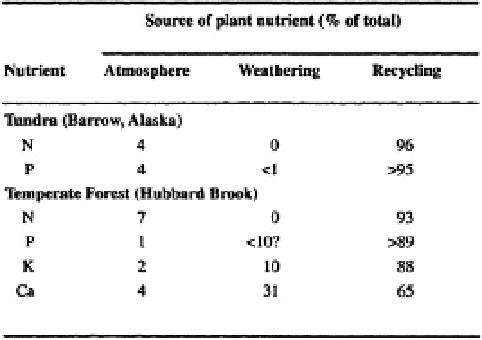Agriculture Reference
In-Depth Information
Decomposition is essentially a biological process. Abiotic chemical oxidation is unlikely
to account for more than 20 % of total evolution from soils (Scharpenseel
et al.‚
1984; Seastedt‚ 1984; Moorhead and Reynolds‚ 1989; Warneke
et al.‚
1999). At least
80 %‚ and normally more than 95 % of may therefore be derived from organismal
respiration. Nutrients taken up by plants in natural environments are derived largely
from decomposition processes (Table IV. 1 and I.2) although the proportions derived
from mineral weathering and other sources differ among soil and ecosystem types‚ and
with the nutrient considered.
Micro-organisms are by far the major contributors to soil respiration and are
responsible for 80 to 95 % of the total respired and consequently of the organic C
mineralised (Satchell‚ 1971; Ryszkowski‚ 1975; Reichle
et al.‚
1975; Persson and Lohm‚
1977; Lamotte‚ 1975‚ 1989). Consideration of their ecological traits is of paramount
importance in understanding decomposition dynamics‚ since low levels of micro-
organism activity may result directly in complete or partial inhibition of decomposition
(see
e.g
.‚ Trofymow and Coleman‚ 1982). This is mainly due to their relative lack
of mobility‚ depression of their activities under extreme temperature and moisture
conditions‚ metabolic specificity and susceptibility to chemical inhibition and partial
inactivation when covered with crystalline clay particles (see the 'Sleeping Beauty
paradox'‚ Chapter III.2.4.3).
Decomposition processes are therefore determined by interactions among three
factors‚ namely‚ organisms‚ environmental conditions (particularly the climate and
the suite of minerals present in the soil) and the quality of the decomposing resources
(Swift
et al.‚
1979; Anderson and Flanagan‚ 1989). These three factors are not equally
important since they operate at different spatial and temporal scales and may have
opposing influences on decomposition processes. It therefore seems more appropriate
to use an hierarchical model to describe the factors determining decomposition than
the triangular scheme proposed by Swift
et al.
(1979).




